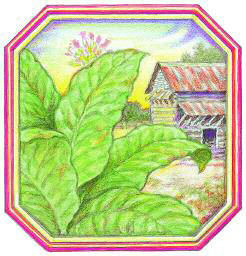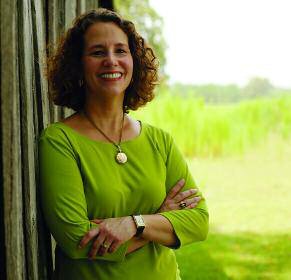
Nicotiana tabacum. It’s a lovely plant, really–large, bright green leaves on a central stem that reaches 6 feet or more.Mid-season, a fat cluster of nearly white tube flowers crown the stem. It’s a hardy plant, too, resistant to both heat and drought. Perfect for the land I call home.
I grew up on a tobacco and cotton farm in eastern North Carolina.My cousins and many ofmy friends did, too.We never thought much about being part of a community whose fertile heritage included growing a product that has contributed to the deaths of thousands upon thousands. The grownups paid it no mind, either.
Daddy used to say that cotton was king. But the real lord and master in these parts was tobacco.
Flue-cured tobacco, the crème de la crème. Grown primarily in the Carolinas,Virginia, Georgia and Florida, it fairs especially well in the sandy loam that distinguishes this western edge of the coastal plain. Our tobacco is grade A prime produce.
Today the tobacco industry is light years from where it stood some 40 years ago when I was girl, but it is by no means a dead or even dying trade.The Federal Tobacco Quota Buyout in 2004 ended a price support system in place since the 1930s that determined how much would be grown where.
Everyone said the buyout would prove the end for tobacco growers. Even though fewer farmers in this part of the state now grow the crop, those who do have increased their farm size and are growing more. In fact,North Carolina remains the nation’s leading producer of flue-cured tobacco.

I am proud to be a member of an evershrinking community that worked on a traditional tobacco farm. In those days tobacco was planted, tended and harvested by human hands. Lots of them.
In the late fall we planted tobacco seeds in frames and covered themwith porous fabric. By spring of the following year, the seedlings were ready.
Farm workers sat on a tobacco planter, which was four seats wide and hitched to a mule, and dropped the little plants in rows of freshly turned soil.Mid-season,when those pretty flowers were blooming,workers walked up and down each row to cut them off–called “topping”–so that all the nourishment would go into the leaves.
By July tobacco was ready to harvest.When farmers were “putting in” tobacco, other chores were left undone.We worked steadily through the day, every day except Sunday, with a break for lunch. It was grimy, sweaty, hard work, and because of it many a girl and boy came to appreciate that a college education might be useful.
Hand labor for the harvesting of tobacco was considerable. Both whites and blacks worked on our land.The Hispanics who comprise the bulk of farm workers in North Carolina now weren’t here then.
I don’t remember race being so much an issue as gender and age. The boys and men worked in the fields and picked the leaves, called “priming.”They picked from the bottom up, grabbing just the larger leaves, allowing the smaller ones toward the top to mature a few weeks more.
They laid the leaves in a “slide,”which was a mule-drawn long wooden box that slid down a row just wide enough for it and a mule. A “trucker” drove the mule. I coveted this job because I was horse crazy at the time, and mules were as close to a horse as I could get. But Daddy wouldn’t let me be a trucker; I was a girl, and girls just didn’t do that.
When the slide was full, the trucker brought it to the barn. Tobacco barns were built in clusters of at least two and often four. One of the barns was usually constructed with a shelter attached, and those not in the field worked under that shelter.
Children, girls (including me) and young women were “handers.”Handers grabbed four or five leaves, clumped them together, and handed them, stems out, to the “looper,” who was typically an older woman.
She tied the handfuls of tobacco on a stick with cotton twine. They were not fastened in knots, exactly, but the string was wound around the bunches in such a way as to hold them fast.When a stick was full, we hung it on a frame.When the frames were full, the strongest and most agile of the young men hung the sticks on rafters in the barn.
Once a barn was full, the process of curing began. The green leaves were dried by heat. Gas-fired stoves with flues for sending out heat sat on the dirt floor of the barn, and as their heat rose, baking the leaves, they gradually turned from green to yellow-gold.When they were completely dry, the leaves were removed from the sticks and taken to a nearby warehouse, where they were put in piles and graded. Buyers from tobacco companies would walk among the piles and bid on their favorites.
Tobacco warehouses were dim, hot and musty. I can still see the piles of yellow leaves and smell their sweet pungent musk. It always made me queasy, and I seldom accompanied my father to the warehouses because of it.
Aside from the heat, humidity, long days, and sheer boredom of putting in tobacco, it’s a grimy crop. Tobacco leaves have short hairs that produce a thick, sticky substance called “gum.” After a few hours, black tobacco gum would be glued to your clothes, your hands, and anything you touched. Lava soap and Comet cleanser would take most of it off, but even then, by the end of the week scrubbing was futile–it had to wear off.
I worked in tobacco for just a couple of years. As soon as I was old enough to drive, I found a summer job in air conditioning, working as a hostess-cashier at a Ramada Inn. It was paradise.
My father died in 1994, and my mother has rented our land to other farmers since. Sometimes they raise tobacco, but usually they grow peanuts, soybeans or, like this year, corn. Everyone is growing corn for ethanol.
I have been thinking recently about why I don’t feel guilty about my hand in growing tobacco. There are many reasons: It has been grown for centuries before me, and smoking is a personal choice.Also, I used the product for about 10 years. I fought the war and survived, so to speak. Quitting was tough, but I never swore at tobacco.
It has contributed greatly to my good life. It bought me a horse, sent me to college, carried me to England one summer, and purchased my first car. Tobacco built the region of North Carolina in which I live, and it did the same for other parts of the state. If I were anything other than grateful to tobacco, I would be a hypocrite.
Today when I pass a tobacco field, I don’t see cancer and caskets. I see Susie,my favorite looper; Betty Jean,my best childhood friend; and those young men hanging sticks of green leaves up high in the barn. Tobacco is wound tightly through some of my best childhood memories, and it defines more than a little my early years on the family farm.